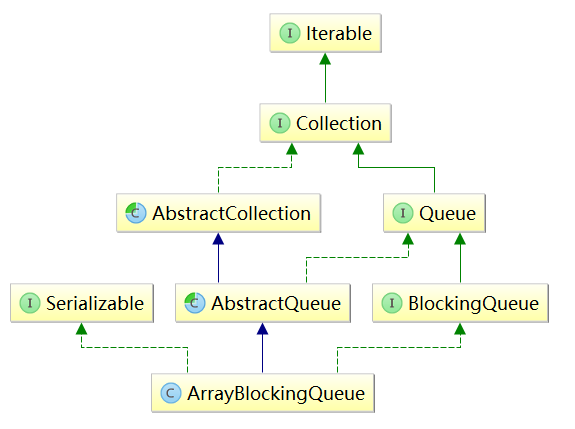并发容器学习—ArrayBlockingQueue
2019-05-02 10:44
190 查看
一、ArrayBlockingQueue并发容器
1.ArrayBlockingQueue的继承体系
见名知义,ArrayBlockingQueue是个由数组支持的有界阻塞队列。也遵循先进先出(FIFO)的原则,也就是说ArrayBlockingQueue的容量是有限的,并不能像ArrayList那样自动扩容。ArrayBlockingQueue的继承关系如下图所示:

其中除了BlockingQueue接口未接触过,其余的类和接口都已经分析过,不在赘言。
public interface BlockingQueue<E> extends Queue<E> {
//将指定的元素添加到队尾,若队列容量已满,则抛异常
boolean add(E e);
//将指定的元素添加到队尾,若队列容量已满,那么放弃添加,返回false
boolean offer(E e);
//将指定的元素添加到队尾,若队列已满,那么等待队列有容量时在添加
//可被中断
void put(E e) throws InterruptedException;
//在一定时间内尝试将指定元素添加到队尾,若超过指定时间仍未添加成功,
//则放弃添加,返回false
boolean offer(E e, long timeout, TimeUnit unit)
throws InterruptedException;
//若队列不为空,则获取并移除队首,若队列为空,则等待队列有元素可用
//可被中断
E take() throws InterruptedException;
//在一定时间内尝试获取并移除队首元素,若超过指定时间仍无可用元素,
//则返回null
E poll(long timeout, TimeUnit unit)
throws InterruptedException;
//返回队列的剩余容量,不包含阻塞中的元素
int remainingCapacity();
//删除队列中的元素o
boolean remove(Object o);
//判断队列中是否含有元素o
public boolean contains(Object o);
//将队列中的所有元素转移到容器c中,队列中不留任何元素
int drainTo(Collection<? super E> c);
//将队列中最多maxElements个元素删除并转移到容器c中
int drainTo(Collection<? super E> c, int maxElements);
}
2.重要的属性及构造方法
public class ArrayBlockingQueue<E> extends AbstractQueue<E>
implements BlockingQueue<E>, java.io.Serializable {
//底层数据存储的数组
final Object[] items;
//队首元素在数组中的索引
int takeIndex;
//队尾元素在数组中的索引
int putIndex;
//队列中元素的个数
int count;
//重入锁,用于同步操作
final ReentrantLock lock;
//条件,允许出队的条件
private final Condition notEmpty;
//允许入队的条件
private final Condition notFull;
//迭代器
transient Itrs itrs = null;
//创建一个容量为capacity的默认队列(不公平的队列)
public ArrayBlockingQueue(int capacity) {
this(capacity, false);
}
//创建一个容量为capacity的队列,是否公平由fair决定
public ArrayBlockingQueue(int capacity, boolean fair) {
if (capacity <= 0)
throw new IllegalArgumentException();
this.items = new Object[capacity]; //数组大小
lock = new ReentrantLock(fair); //公平或不公平锁
notEmpty = lock.newCondition(); //出队条件
notFull = lock.newCondition(); //入队条件
}
//创建一个容量为capacity的队列,是否公平由fair决定,且队列中
//包含有容器c中的元素
public ArrayBlockingQueue(int capacity, boolean fair,
Collection<? extends E> c) {
this(capacity, fair);
final ReentrantLock lock = this.lock;
lock.lock(); //加锁
try {
int i = 0;
try {
for (E e : c) {
checkNotNull(e); //元素不能为null
items[i++] = e;
}
} catch (ArrayIndexOutOfBoundsException ex) {
throw new IllegalArgumentException();
}
count = i;
putIndex = (i == capacity) ? 0 : i;
} finally {
lock.unlock();
}
}
}
3.入队过程
在ArrayBlockingQueue中入队的方法有三个:add、offer和put,都是将元素添加到队尾,我们逐个来看:
//添加元素到队尾,若队列没有剩余容量,则放弃添加
public boolean offer(E e) {
//入队元素不能为null,这里说明ArrayBlockingQueue中不允许有null元素存在
checkNotNull(e);
final ReentrantLock lock = this.lock;
lock.lock(); //加锁
try {
//判断队列中的元素个数是否超过队列容量
//若队列没有剩余容量存放元素,那么就放弃添加
if (count == items.length)
return false;
else {
enqueue(e); //入队方法
return true;
}
} finally {
lock.unlock(); //解锁
}
}
/**
* 入队方法
* ArrayBlockingQueue的入队和出队操作是典型的生产者消费者模式的使用
* ArrayBlockingQueue也是个典型生产者消费者队列,当队列中没有元素(产品)
* 时,会挂起或拒绝所有的出队(消费)操作;当队列中的元素满了时,会挂起或拒
* 绝所有入队(生产)操作。而当队列中有元素时,则会唤醒或接受所有出队操作
* 同理,队列中还有空间时,则会唤醒或接受所有入队操作
*/
private void enqueue(E x) {
//获取底层数组引用
final Object[] items = this.items;
items[putIndex] = x; //将元素添加到队尾
//判断队尾索引是否超过数组的长度
/**
* ArrayBlockingQueue中底层数组采用环形数组来
* 实现数组的重复利用,putIndex永远指向队尾元素的索引
* 因此当putIndex的值等于数组长度时,说明已经到达数组的
* 最大索引,需要回到0的索引位置了
*/
if (++putIndex == items.length)
putIndex = 0;
count++; //元素个数+1
notEmpty.signal(); //唤醒执行出队操作的线程
}
//添加元素到队尾,若队列没有剩余容量,则抛出异常
public boolean add(E e) {
return super.add(e); //父类方法
}
//父类中的add方法
public boolean add(E e) {
//执行子类的offer添加方法判断添加是否成功
if (offer(e))
return true;
else
//添加失败抛出异常
throw new IllegalStateException("Queue full");
}
//在一定时间内尝试将指定元素添加到队尾,若超过指定时间仍未添加成功,
//则放弃添加,返回false
public boolean offer(E e, long timeout, TimeUnit unit)
throws InterruptedException {
checkNotNull(e); //不允许添加null
long nanos = unit.toNanos(timeout); //时间换算
final ReentrantLock lock = this.lock;
lock.lockInterruptibly(); //可被打断的加锁
try {
//循环判断队列是否已满
/**
* 循环判断是为防止‘虚假唤醒’,即有多个入队操作线程被唤醒
* 但若此时只有一个剩余容量,那么这多个入队操作只有一个应该被执行
* 其他的入队操作仍应该继续等待,如果使用if来进行一次性的判断
* 那么就会造成在只有一个一个剩余容量的情况下,执行多次入队操作
* 这是不允许的,因此应该使用while来继续判断队列是否已满,防止出现
* 虚假唤醒。
*/
while (count == items.length) {
if (nanos <= 0)
return false;
nanos = notFull.awaitNanos(nanos); //等待nanos时间
}
enqueue(e);
return true;
} finally {
lock.unlock(); //解锁
}
}
//将指定的元素添加到队尾,若队列已满,那么等待队列有容量时在添加
//可被中断
public void put(E e) throws InterruptedException {
checkNotNull(e);
final ReentrantLock lock = this.lock;
lock.lockInterruptibly(); //可被中断的加锁
try {
//判断队列是否已满,若是队列已满,
//那么执行入队操作的当前线程进入条件队列(条件
//队列指的是重入锁底层AQS同步器中的线程条件队列,
//不是当前的元素队列)中等待,只有队列有剩余空间时
//才会被唤醒尝试入队,这里也存在虚假唤醒的可能,
//因此也需要使用while对唤醒的线程进行在一次的判断
while (count == items.length)
notFull.await();
enqueue(e);
} finally {
lock.unlock();
}
}
4.出队过程
在ArrayBlockingQueue中的出队方法有poll和take方。
//将队首元素移除出队并返回,若队列为空,则返回null
public E poll() {
final ReentrantLock lock = this.lock;
lock.lock();
try {
return (count == 0) ? null : dequeue();
} finally {
lock.unlock();
}
}
//真正执行出队操作的方法
private E dequeue() {
final Object[] items = this.items;
@SuppressWarnings("unchecked")
E x = (E) items[takeIndex]; //获取队尾元素
items[takeIndex] = null; //将队尾元素从数组中移除
//判断队尾元素的索引takeIndex是否超过数组的边界
//超过数组索引最大值,则回到数组的索引起点0
if (++takeIndex == items.length)
takeIndex = 0;
count--; //队列中元素-1
//判断是否使用了队列的迭代器功能
if (itrs != null)
itrs.elementDequeued(); //整理迭代器
//执行了一个出队操作,队列必不可能满,那么可以唤醒一个入队线程
notFull.signal();
return x;
}
//内部类Itrs中的整理迭代器结点的方法
void elementDequeued() {
// assert lock.getHoldCount() == 1;
if (count == 0) //队列中没有元素时,需要清空所有迭代器
queueIsEmpty();
else if (takeIndex == 0)
//队尾索引指向索引0时需要将数组的循环次数+1
//然后对所有的迭代器进行清理,清除耗尽了的迭代器
takeIndexWrapped();
}
//在一定时间内尝试获取并移除队首元素,若超过指定时间仍无可用元素,
//则返回null
public E poll(long timeout, TimeUnit unit) throws InterruptedException {
long nanos = unit.toNanos(timeout);
final ReentrantLock lock = this.lock;
lock.lockInterruptibly(); //可被中断的加锁
try {
//判断队列是否为空,若队列为空则等待一定时间
while (count == 0) {
if (nanos <= 0) //判断等待时间是否合法
return null;
nanos = notEmpty.awaitNanos(nanos); //等待一定时间
}
return dequeue();
} finally {
lock.unlock();
}
}
//移除并返回队首元素,若队列中没有剩余空间,那当前
//出队操作的线程进入AQS条件等待队列中等待条件满足被唤醒
public E take() throws InterruptedException {
final ReentrantLock lock = this.lock;
lock.lockInterruptibly();
try {
//队列为空,进入等待,线程挂起
while (count == 0)
notEmpty.await();
return dequeue();
} finally {
lock.unlock();
}
}
5.peek方法
public E peek() {
final ReentrantLock lock = this.lock;
lock.lock(); //加锁
try {
return itemAt(takeIndex); //返回索引处的元素
lock.unlock();
}
}
//获取数组i索引的元素
final E itemAt(int i) {
return (E) items[i];
}
6.remove方法
public boolean remove(Object o) {
//队列中不存在null元素,要删除null,直接失败
if (o == null) return false;
final Object[] items = this.items;
final ReentrantLock lock = this.lock;
lock.lock();
try {
//判断队列是否是空队列,若是空队列那么
//就不需要去队列中查找,直接删除失败
//否则,再去队列中查找
if (count > 0) {
final int putIndex = this.putIndex; //获取队尾索引
int i = takeIndex; //获取队首索引
//遍历队首到队尾直接的所有元素,查找是否存在要删除的元素
do {
if (o.equals(items[i])) {
removeAt(i); //找到要删除的元素,执行删除方法
return true;
}
if (++i == items.length) //判断索引是否越界,越界归零
i = 0;
} while (i != putIndex);
}
return false;
} finally {
lock.unlock();
}
}
//将索引处元素从数组中移除,并整理数组
void removeAt(final int removeIndex) {
final Object[] items = this.items;
//若要删除的元素索引正好是队尾元素,那么直接删除替换成null即可
if (removeIndex == takeIndex) {
items[takeIndex] = null; //删除元素
if (++takeIndex == items.length) //索引越界归零
takeIndex = 0;
count--; //元素个数-1
if (itrs != null) //整理迭代器
itrs.elementDequeued();
} else {
//要删除的元素索引不为队尾元素,那么删除的元素空出来的位置需要将后续
//到队尾的元素全都索引+1
final int putIndex = this.putIndex;
for (int i = removeIndex;;) {
int next = i + 1;
if (next == items.length) //下个索引是否越界,越界归零
next = 0;
//判断移动数组中索引是否到达队尾
//不是队尾索引的话,将下个索引中元素移到当前索引即可
//到达队尾索引,则要赋为null,并且队尾索引要改变成当前索引
if (next != putIndex) {
items[i] = items[next];
i = next;
} else {
items[i] = null;
this.putIndex = i;
break;
}
}
count--; //元素个数-1
if (itrs != null) //整理迭代器
itrs.removedAt(removeIndex);
}
notFull.signal(); //唤醒入队操作
}
7.size方法
public int size() {
final ReentrantLock lock = this.lock;
lock.lock();
try {
return count; //队列元素个数
} finally {
lock.unlock();
}
}
相关文章推荐
- java并发编程-同步类容器-ArrayBlockingQueue
- Java 7之多线程并发容器 - ArrayBlockingQueue
- Thread学习(九) 并发的Queen学习ArrayBlockingQueue,LinkedBlockingQueue
- Java concurrent Framework并发容器之ArrayBlockingQueue(1.6)源码分析
- Java并发学习笔记(七)-ArrayBlockingQueue
- Java并发学习(二十二)-ArrayBlockingQueue分析
- 并发容器学习—LinkedBlockingQueue和LinkedBlockingDueue
- 并发容器学习—DelayQueue与PriorityBlockingQueue
- Java并发容器之ArrayBlockingQueue
- 并发容器分析(二)--ArrayBlockingQueue
- ( 十)并发包阻塞队列之ArrayBlockingQueue
- Java并发编程与技术内幕:ArrayBlockingQueue、LinkedBlockingQueue及SynchronousQueue源码解析
- 并发容器学习—LinkedTransferQueue
- JDK并发工具类源码学习系列——PriorityBlockingQueue
- JAVA并发之阻塞队列LinkedBlockingQueue与ArrayBlockingQueue
- 并发队列 – 有界阻塞队列 ArrayBlockingQueue 原理探究
- JDK容器与并发—Queue—PriorityBlockingQueue
- Java多线程与并发应用-(10)-java阻塞队列实现ArrayBlockingQueue
- 详细分析Java并发集合ArrayBlockingQueue的用法
- 移动端并发编程基础篇-阻塞队列ArrayBlockingQueue&LinkedBlockingQueue
